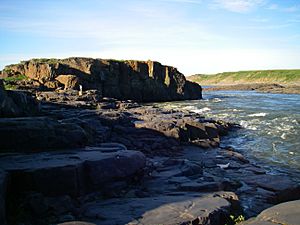Bloody Falls massacre facts for kids
The Bloody Falls incident was a sad event that is thought to have happened on July 17, 1771. It involved Hudson's Bay Company explorer Samuel Hearne. He was looking for copper along the Coppermine River in what is now Kugluktuk, Nunavut, Canada.
Hearne's original travel diary is now lost. The story we know was published after he died, with some changes. This story says that Chipewyan and "Copper Indian" Dene men attacked a group of Copper Inuit. The Inuit were camped by rapids about 15 km (9.3 mi) upstream from the Coppermine River's mouth. Hearne's guide, Matonabbee, led the attack.
Getting Ready for the Journey
In May 1771, Samuel Hearne noticed something different about the Chipewyan people with him. They seemed to have other plans besides exploring the Coppermine River. When they reached Peshew Lake, Matonabbee and other men arranged for their wives and children to stay behind.
At Clowey Lake, the Chipewyan men made shields. These shields were about 60 cm (2 ft) wide and 90 cm (3 ft) long. Hearne saw that more Indigenous people joined his group. These new people seemed only interested in fighting the Inuit.
Hearne wrote that as they moved north, it became clear his companions were planning a violent act. However, the Dene people of the area say Hearne was not actually there. Other people from Hearne's time also questioned his story. The oral history of the Inuit-Dene conflict does not include the Bloody Falls story either.
Hearne tried to stop his guides, but he failed. He wrote that his pleas did not work. His companions thought he was being a coward. On June 1, 1771, the remaining women, children, dogs, and heavy bags were left behind. About 60 men then moved north toward the Coppermine River.
On July 2, 1771, the group met some Copper Indians. These people learned about the expedition's goal. They gave Hearne's group canoes and other supplies. But 17 men left the group in the next few days. They said the journey was too hard, and killing Inuit was not worth it.
The rest of the group arrived at the Coppermine River on July 14, 1771. Three scouts were sent to find any Inuit camps nearby. Hearne started his survey work. On July 16, 1771, the scouts returned. They reported finding five Inuit tents on the west side of the river. This news stopped the survey work completely. The men began to get ready for a fight.
The Incident
Just after midnight on July 17, the Dene group attacked the Inuit camp. About 20 men, women, and children were killed. Hearne said he was very upset by what he saw. He wrote, "Even now I cannot think about that terrible day without crying." He claimed he named the waterfall Bloody Falls.
What Happened After
The place where the incident happened was the traditional home of the Kogluktogmiut people. It is now part of Kugluk/Bloody Falls Territorial Park near Kugluktuk, Nunavut. In 1978, it became a National Historic Site.
It was named a historic site not just because of the reported incident. It was also recognized as a very old fishing spot. It also has small caribou hunting stations. These show that Pre-Dorset, Thule, First Nation, and Inuit cultures lived there for thousands of years.
The incident is also mentioned in a poem by John Newlove called Samuel Hearne in Wintertime.
See also
- List of massacres in Canada
Images for kids



